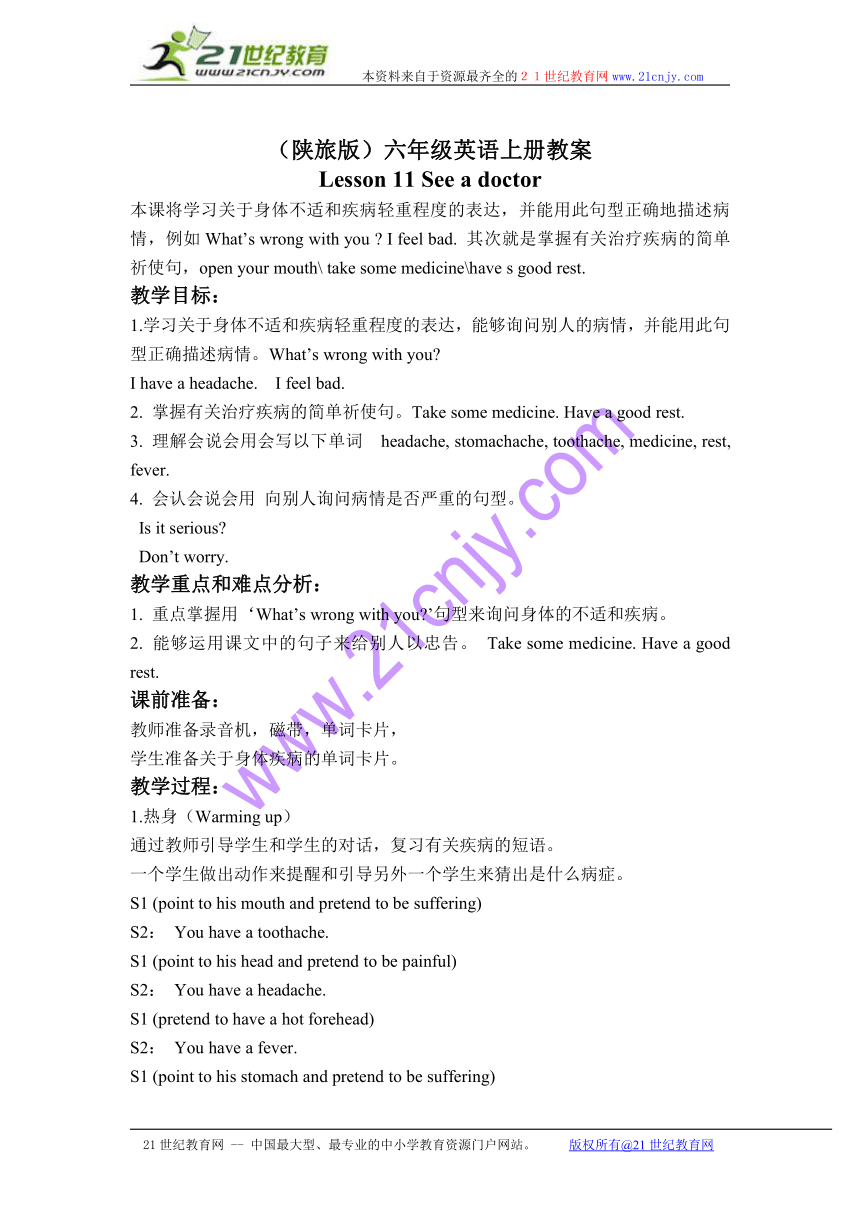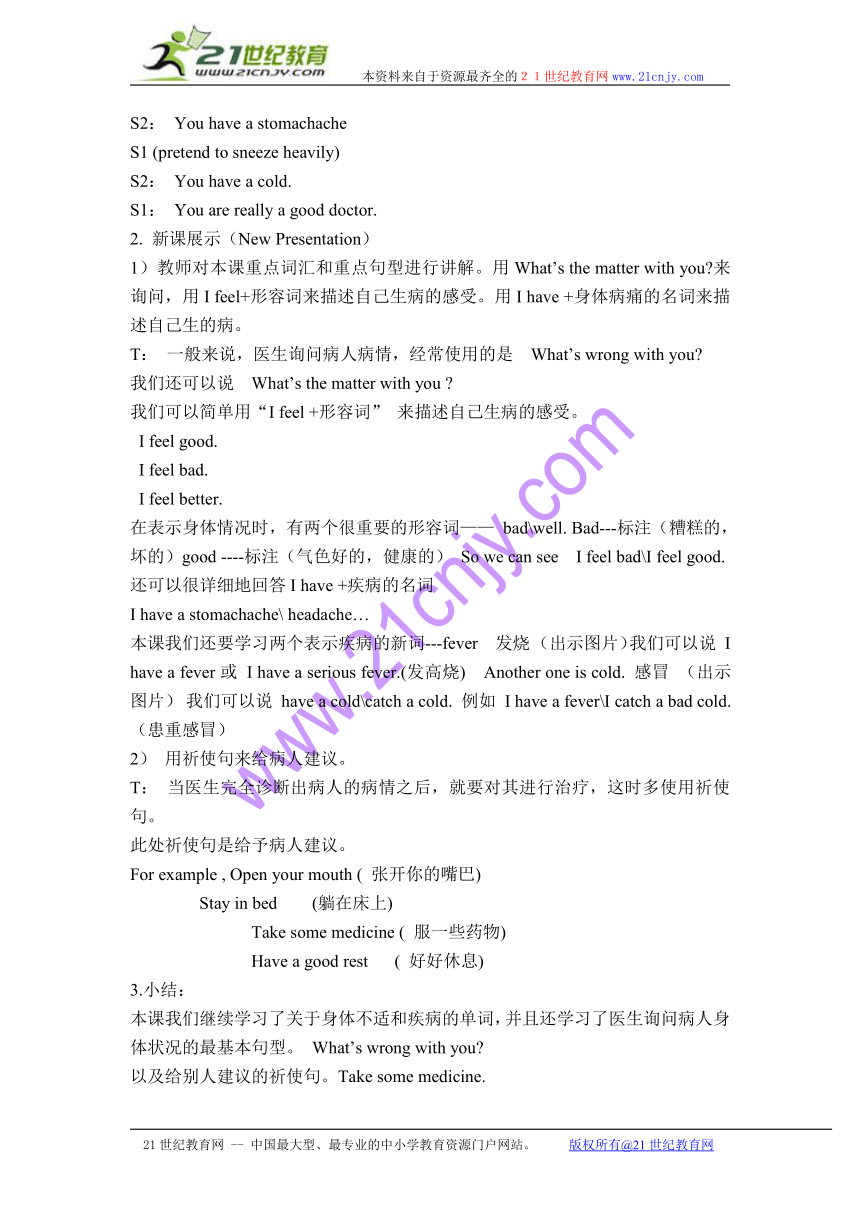六年级英语上册教案 lesson 11(1)(陕旅版)
文档属性
| 名称 | 六年级英语上册教案 lesson 11(1)(陕旅版) |  | |
| 格式 | rar | ||
| 文件大小 | 12.5KB | ||
| 资源类型 | 教案 | ||
| 版本资源 | 陕旅版 | ||
| 科目 | 英语 | ||
| 更新时间 | 2010-07-15 08:30:00 | ||
图片预览


文档简介
本资料来自于资源最齐全的21世纪教育网www.21cnjy.com
(陕旅版)六年级英语上册教案
Lesson 11 See a doctor
本课将学习关于身体不适和疾病轻重程度的表达,并能用此句型正确地描述病情,例如What’s wrong with you I feel bad. 其次就是掌握有关治疗疾病的简单祈使句,open your mouth\ take some medicine\have s good rest.
教学目标:
1.学习关于身体不适和疾病轻重程度的表达,能够询问别人的病情,并能用此句型正确描述病情。What’s wrong with you
I have a headache. I feel bad.
2. 掌握有关治疗疾病的简单祈使句。Take some medicine. Have a good rest.
3. 理解会说会用会写以下单词 headache, stomachache, toothache, medicine, rest, fever.
4. 会认会说会用 向别人询问病情是否严重的句型。
Is it serious
Don’t worry.
教学重点和难点分析:
1. 重点掌握用‘What’s wrong with you ’句型来询问身体的不适和疾病。
2. 能够运用课文中的句子来给别人以忠告。 Take some medicine. Have a good rest.
课前准备:
教师准备录音机,磁带,单词卡片,
学生准备关于身体疾病的单词卡片。
教学过程:
1.热身(Warming up)
通过教师引导学生和学生的对话,复习有关疾病的短语。
一个学生做出动作来提醒和引导另外一个学生来猜出是什么病症。
S1 (point to his mouth and pretend to be suffering)
S2: You have a toothache.
S1 (point to his head and pretend to be painful)
S2: You have a headache.
S1 (pretend to have a hot forehead)
S2: You have a fever.
S1 (point to his stomach and pretend to be suffering)
S2: You have a stomachache
S1 (pretend to sneeze heavily)
S2: You have a cold.
S1: You are really a good doctor.
2. 新课展示(New Presentation)
1)教师对本课重点词汇和重点句型进行讲解。用What’s the matter with you 来询问,用I feel+形容词来描述自己生病的感受。用I have +身体病痛的名词来描述自己生的病。
T: 一般来说,医生询问病人病情,经常使用的是 What’s wrong with you
我们还可以说 What’s the matter with you
我们可以简单用“I feel +形容词” 来描述自己生病的感受。
I feel good.
I feel bad.
I feel better.
在表示身体情况时,有两个很重要的形容词—— bad\well. Bad---标注(糟糕的,坏的)good ----标注(气色好的,健康的) So we can see I feel bad\I feel good.
还可以很详细地回答I have +疾病的名词
I have a stomachache\ headache…
本课我们还要学习两个表示疾病的新词---fever 发烧 (出示图片)我们可以说 I have a fever或 I have a serious fever.(发高烧) Another one is cold. 感冒 (出示图片) 我们可以说 have a cold\catch a cold. 例如 I have a fever\I catch a bad cold.(患重感冒)
2) 用祈使句来给病人建议。
T: 当医生完全诊断出病人的病情之后,就要对其进行治疗,这时多使用祈使句。
此处祈使句是给予病人建议。
For example , Open your mouth ( 张开你的嘴巴)
Stay in bed (躺在床上)
Take some medicine ( 服一些药物)
Have a good rest ( 好好休息)
3.小结:
本课我们继续学习了关于身体不适和疾病的单词,并且还学习了医生询问病人身体状况的最基本句型。 What’s wrong with you
以及给别人建议的祈使句。Take some medicine.
Have a good rest.
4.巩固活动:
1)教师引导学生两人一组,自编对话。
S1: Morning. Can I help you
S2: Morning. I need your help.
S1: What’s wrong with you
S2: I have a stomachache.
S1: Let me look over. What did you eat last night
S2: I ate lots of ice cream and some peaches.
S1: Are the peaches green
S2: Yes. How do you know
S1:That is it. Take some medicine and have a good rest. It’s not serious.
S2: Thank you.
S1: You’re welcome.
2)听录音学习对话。Listen to the dialogue and answer the questions. 然后听并跟读。
T: What’s the matter with Tom
Ss: He has a cold.
T: Is it serious
Ss: No, it isn’t.
T: What does the doctor suggest
Ss: He says that Tom should take some medicine and have a good rest.
3) Read and choose.
A: 本题主要是依据特殊短语的固定用法来选择。
A: What’s wrong with you
B: I feel very bad. I have a headache.
A: Oh, you have a cold. You’re having a fever now.
B: Is it serious
A: Don’t worry. Nothing serious. Take the medicine and have a rest. You’ll be well soon.
B: Thanks a lot.
4) Match and practise.
A: What’s wrong with you
B: I have a cold.
A: You’d better drink more water.
A: What’s wrong with you
B: I have a toothache.
A: You’d better not eat too much sweet.
A: What’s wrong with you
B: I have a stomachache.
A: You’d better not eat too much.
21世纪教育网 -- 中国最大型、最专业的中小学教育资源门户网站。 版权所有@21世纪教育网
(陕旅版)六年级英语上册教案
Lesson 11 See a doctor
本课将学习关于身体不适和疾病轻重程度的表达,并能用此句型正确地描述病情,例如What’s wrong with you I feel bad. 其次就是掌握有关治疗疾病的简单祈使句,open your mouth\ take some medicine\have s good rest.
教学目标:
1.学习关于身体不适和疾病轻重程度的表达,能够询问别人的病情,并能用此句型正确描述病情。What’s wrong with you
I have a headache. I feel bad.
2. 掌握有关治疗疾病的简单祈使句。Take some medicine. Have a good rest.
3. 理解会说会用会写以下单词 headache, stomachache, toothache, medicine, rest, fever.
4. 会认会说会用 向别人询问病情是否严重的句型。
Is it serious
Don’t worry.
教学重点和难点分析:
1. 重点掌握用‘What’s wrong with you ’句型来询问身体的不适和疾病。
2. 能够运用课文中的句子来给别人以忠告。 Take some medicine. Have a good rest.
课前准备:
教师准备录音机,磁带,单词卡片,
学生准备关于身体疾病的单词卡片。
教学过程:
1.热身(Warming up)
通过教师引导学生和学生的对话,复习有关疾病的短语。
一个学生做出动作来提醒和引导另外一个学生来猜出是什么病症。
S1 (point to his mouth and pretend to be suffering)
S2: You have a toothache.
S1 (point to his head and pretend to be painful)
S2: You have a headache.
S1 (pretend to have a hot forehead)
S2: You have a fever.
S1 (point to his stomach and pretend to be suffering)
S2: You have a stomachache
S1 (pretend to sneeze heavily)
S2: You have a cold.
S1: You are really a good doctor.
2. 新课展示(New Presentation)
1)教师对本课重点词汇和重点句型进行讲解。用What’s the matter with you 来询问,用I feel+形容词来描述自己生病的感受。用I have +身体病痛的名词来描述自己生的病。
T: 一般来说,医生询问病人病情,经常使用的是 What’s wrong with you
我们还可以说 What’s the matter with you
我们可以简单用“I feel +形容词” 来描述自己生病的感受。
I feel good.
I feel bad.
I feel better.
在表示身体情况时,有两个很重要的形容词—— bad\well. Bad---标注(糟糕的,坏的)good ----标注(气色好的,健康的) So we can see I feel bad\I feel good.
还可以很详细地回答I have +疾病的名词
I have a stomachache\ headache…
本课我们还要学习两个表示疾病的新词---fever 发烧 (出示图片)我们可以说 I have a fever或 I have a serious fever.(发高烧) Another one is cold. 感冒 (出示图片) 我们可以说 have a cold\catch a cold. 例如 I have a fever\I catch a bad cold.(患重感冒)
2) 用祈使句来给病人建议。
T: 当医生完全诊断出病人的病情之后,就要对其进行治疗,这时多使用祈使句。
此处祈使句是给予病人建议。
For example , Open your mouth ( 张开你的嘴巴)
Stay in bed (躺在床上)
Take some medicine ( 服一些药物)
Have a good rest ( 好好休息)
3.小结:
本课我们继续学习了关于身体不适和疾病的单词,并且还学习了医生询问病人身体状况的最基本句型。 What’s wrong with you
以及给别人建议的祈使句。Take some medicine.
Have a good rest.
4.巩固活动:
1)教师引导学生两人一组,自编对话。
S1: Morning. Can I help you
S2: Morning. I need your help.
S1: What’s wrong with you
S2: I have a stomachache.
S1: Let me look over. What did you eat last night
S2: I ate lots of ice cream and some peaches.
S1: Are the peaches green
S2: Yes. How do you know
S1:That is it. Take some medicine and have a good rest. It’s not serious.
S2: Thank you.
S1: You’re welcome.
2)听录音学习对话。Listen to the dialogue and answer the questions. 然后听并跟读。
T: What’s the matter with Tom
Ss: He has a cold.
T: Is it serious
Ss: No, it isn’t.
T: What does the doctor suggest
Ss: He says that Tom should take some medicine and have a good rest.
3) Read and choose.
A: 本题主要是依据特殊短语的固定用法来选择。
A: What’s wrong with you
B: I feel very bad. I have a headache.
A: Oh, you have a cold. You’re having a fever now.
B: Is it serious
A: Don’t worry. Nothing serious. Take the medicine and have a rest. You’ll be well soon.
B: Thanks a lot.
4) Match and practise.
A: What’s wrong with you
B: I have a cold.
A: You’d better drink more water.
A: What’s wrong with you
B: I have a toothache.
A: You’d better not eat too much sweet.
A: What’s wrong with you
B: I have a stomachache.
A: You’d better not eat too much.
21世纪教育网 -- 中国最大型、最专业的中小学教育资源门户网站。 版权所有@21世纪教育网
